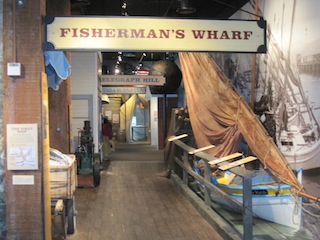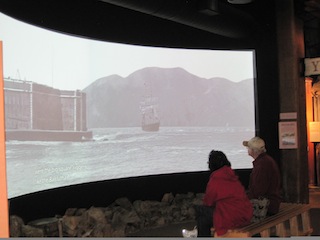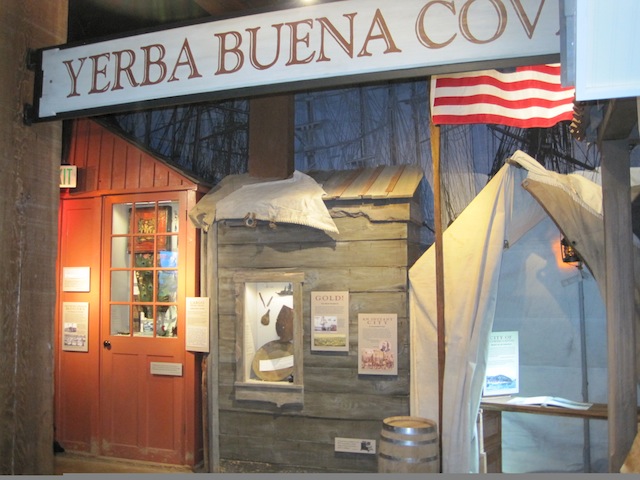By: Jenny Meyer
It is safe to say that we are living in a time where most people are looking to save money and one of those ways is through “Do It Yourself” (DIY) projects. However many museums have been practicing the DIY mentality before it became popular.
I spent some time in 2006 working with Richard Everett and Amy Hosa at the San Francisco National Maritime Historic Park working on the exhibit “Cargo is King” which is installed aboard Balclutha a floating 1886 ship. I found that they did most of their exhibit work in house and that it was very hands-on. The opportunity to take on many roles, is what drew me to museums. There is a continual need to wear many hats along with something new to be done and learned everyday. I recently went back to help them with their latest exhibit The Waterfront located in their Park’s Visitor Center. The exhibit is a time machine that takes visitors on an immersive walk along the edge of San Francisco's historic working waterfront.
 I interviewed Richard Everett, San Francisco National Historic Park’s Museum Curator and project manager of The Waterfront to discover from his point of view as both museum professional and DIY exhibit expert, what it was like to produce and build this exhibit in-house.
I interviewed Richard Everett, San Francisco National Historic Park’s Museum Curator and project manager of The Waterfront to discover from his point of view as both museum professional and DIY exhibit expert, what it was like to produce and build this exhibit in-house.
1. What was the process to create a new exhibit in the Visitor Center at the San Francisco Maritime National Historical Park?
The front of the Visitor Center is your typical Visitor Center and orientation area with few artifacts and a basic orientation to maritime history. It sets the stage for the much richer exhibit in the back and was completed nine years ago. Although we designed the whole project from front to back, the back end of the Visitor Center was not completed until recently and the build-out took three years. It took seven years before we actually had enough money lined up to build the back and so during that time we installed a succession of three large temporary exhibits.
It took months and months of bureaucratic paperwork to get the money for the new portion, and the highest amount that we could ask for was 400,000 dollars. My team and I knew that was not enough, but we also thought we could get more and luckily that turned out to be the case.
We were lucky to have the experience and ability in-house to manage and hire experienced people to augment our staff, although it wasn’t all in-house with the design and planning. I managed to convince Dean Weldon of Academy Studios, to take on the job of designing the exhibit with us. His staff and ours collaborated on a design for the whole project. We worked as a team coming up with the content, photo choices, the writing, and the layout of everything.
2. What was the inspiration for “The Waterfront”?
The inspiration for The Waterfront actually arose from the ashes of failing to design a great and worthy exhibit for the back of the Visitor Center. Initially we tried to do a major review that included all of west coast maritime history in a 3000 square foot space, since that is the mission of our park. Because the stakes were high, we luckily had a formative evaluation done to test our approach . Many groups of people were consulted: tourists at the airport, tourists at Fisherman’s Warf, parents with children, educators, and also other museum professionals. The different groups were polled and they all said essentially it was “boring”. “It feels like a history lecture”, and “It tries to cover too much.”
So, Stephen Canright, the park historian then came up with the solution for the The Waterfront late one night. When he came in to work the next day he excitedly presented his idea to Amy Hosa, Visual Information Specialist, and myself. Stephen’s idea essentially began by  recognizing that most of West Coast maritime history came to San Francisco and since San Francisco’s maritime history was what people really wanted to learn about first and foremost, “lets tell it as if they were walking along the waterfront of San Francisco back in time”. It can be immersive and can tell the story of the different kinds of shipping but also the stories of immigrants that came to our wharfs from around the world. Our imaginations took off and we fell in love with it. Everything else just seemed to drop into place.
recognizing that most of West Coast maritime history came to San Francisco and since San Francisco’s maritime history was what people really wanted to learn about first and foremost, “lets tell it as if they were walking along the waterfront of San Francisco back in time”. It can be immersive and can tell the story of the different kinds of shipping but also the stories of immigrants that came to our wharfs from around the world. Our imaginations took off and we fell in love with it. Everything else just seemed to drop into place.
3. What do you feel is the importance of why people should know about the Waterfront?
San Francisco has completely changed from the old maritime San Francisco that once was. The city leads as a center for creative thinking; in business, art, science and all kinds of other ways. Because it was a port, so many nationalities, people, immigrants, sailors and working types came here from all over the world, which lent the city its somewhat unique character and its multinational charm, its liberalism, politics and its creativity. Others of course… don’t agree with that but many do. It is important to show people all of history. People benefit from knowing their pasts, their peoples past, and their locations past so they know where they are and how far along they have come. Then we can learn from mistakes of the past, or choose from the best of the past to help create the future. We hold a mirror up against what the old waterfront use to look like, what its character was, and we try to show what vestiges are still left today and how they influence the city. The old Waterfront influences today’s San Francisco and that is what we are trying to show.
4. What was the biggest challenge of building the exhibit?
The biggest challenge was to get it done. We knew we didn’t want to contract it out, because we had done it that way with the front of the visitor center and it that had cost almost a million dollars and could have been better. In addition, the low side estimate for building the back was 1.4 million with 6 computer kiosks; we eliminated the computer kiosks and substituted three video kiosks. Our staff had lots of experience building exhibits ourselves and so we knew we could do it for less. It would take more time, since money was the problem more so than time. The biggest challenge was bringing it in on budget. Still given that 2003 1.4 million estimate, we built it for a million flat, nine years later. I looked up the dollar difference in inflation and that is almost half price.
 The biggest challenge was the amount of work, and to do it yourself at a museum quality level. The huge number of revisions, the technical challenges, hanging things at unusual angles and packing the exhibit full of films and audios…
The biggest challenge was the amount of work, and to do it yourself at a museum quality level. The huge number of revisions, the technical challenges, hanging things at unusual angles and packing the exhibit full of films and audios…
5. Looking back, what advice would you give yourself knowing now what you know now?
One of the main things I learned, is that the project manager needs to be on site—in the space, in the office—where all the decisions need to be made all the time. Being right on site is important to ensuring that things are efficient, the right decisions are being made, and things are not over or under built. Also, try to focus on one thing at a time, impossible though that is.
6. What would be your advise to other historic museums and staff wanting to create a exhibit?
First be really sure your plan is worth doing! I mean if you are doing it for the public ask them in an unbiased way if they would like it. The only way to really achieve this may be to work with an outside experienced evaluation team. Examine the goal then test first in real life whether this is what it actually should be. Really watch your estimates, budget estimates, and time. The quantity of work can get to you at times, so it is important to the people you are managing and project managing to keep it fun and moving forward at all times.









Add new comment